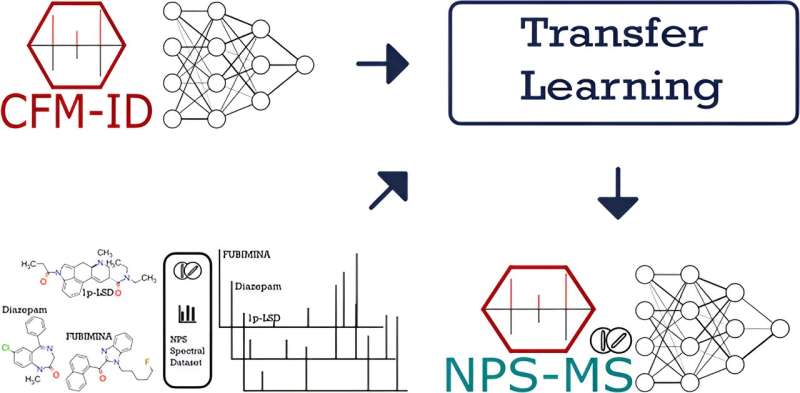This article has been reviewed according to Science X's editorial process and policies. Editors have highlighted the following attributes while ensuring the content's credibility:
fact-checked
peer-reviewed publication
trusted source
proofread
AI-powered platform could help law enforcement get ahead of designer drugs

An online platform powered by deep learning can predict the makeup of new psychoactive substances to help law enforcement in the fight against dangerous drugs.
Called NPS-MS, the platform houses a method that predicts novel psychoactive substances using deep learning, a type of machine learning in the field of artificial intelligence that involves training computing algorithms using large data sets to uncover complex relationships and create predictive models.
"Illegal drugs are a small group of very similar-looking structures," says Fei Wang, a doctoral student in the Department of Computing Science at the University of Alberta and first author on the international study. "The nature of psychoactive substances is that their structures are constantly evolving."
More than 1,000 such substances have been synthesized in the past decade, designed to mimic the effects of drugs like cocaine and methamphetamine while skirting laws that don't yet account for new chemical analogs.
"We hope this program will reduce the flow of illegal drugs that hurt people and society," says study co-author Russ Greiner, computing science professor and Canada CIFAR AI Chair at the Alberta Machine Intelligence Institute (Amii).
Laboratory work to identify novel psychoactive substances requires expensive reference data and labor-intensive testing to produce spectrographs—chemical information references that can be used to confirm an unknown substance.
Wang's research began with programming machine learning tools to aid in studying human metabolites and small molecules. After adapting a machine learning method to identify novel psychoactive substances, NPS-MS was trained using results from DarkNPS, a generative model built at the U of A to predict the spectrograph of potential NPS compounds.
After researchers in Denmark noticed Wang's computing technology might apply to identifying novel psychoactive substances, NPS-MS successfully identified a variant of phencyclidine, more commonly known as PCP, without the use of any reference standards.
The NPS-MS algorithm uses a data set of 1,872 spectrographs to cross-reference 624 new psychoactive substances.
"With machine learning, there are no limitations to how many compounds we can collect for a data set," says Wang.
Wang says about 40,000 molecules have high-resolution spectrometry data available for forensic teams to cross-reference unknown substances, noting that databases containing more of the around 100 million known chemical substances can be expensive for labs to obtain.
"NPS-MS will greatly reduce the amount of work involved for labs."
The work is published in the journal Analytical Chemistry.
More information: Fei Wang et al, Deep Learning-Enabled MS/MS Spectrum Prediction Facilitates Automated Identification Of Novel Psychoactive Substances, Analytical Chemistry (2023). DOI: 10.1021/acs.analchem.3c02413
Journal information: Analytical Chemistry
Provided by University of Alberta





















